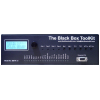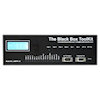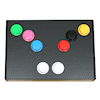Background
At the Black Box ToolKit we specialize in helping you achieve millisecond accurate presentation, synchronization, and response timing in your computer-based psychology experiments. Here are just a few of the things that can stop you doing just that!- TFT Input lag
- TFT response time
- Image intensity
- Sound card latency
- Response devices
- Voice keys
- 3rd party equipment
- OS issues
- Software settings
- Conditional biases
- The laws of physics




Need more help?
If you are unsure of how our products could work for you take a look at our What, Why and How pages. Answers to common application questions can be found in the FAQ section.If you have an application in mind but aren't sure, feel free to get in touch via email. Alternatively contact us by mail, phone or fax. We are here to help!
TFT panel and data projector response time in psychology experiments
 Panel or data projector
response time is not the same as input lag but instead is a
measure of how long it takes an individual pixel on the panel or
data projector to switch between two colours (usually from grey to
grey as that gives manufacturers the fastest time). By "panel" we
mean the physical TFT panel, or projection mechanism, as opposed
to the whole monitor which includes the electronics needed to
process the image. Panels or data projectors with a slow response
time are prone to blurring moving images. Subtly blurring moving
images will have an effect both on visual perception and speed of
response or reaction time.
Panel or data projector
response time is not the same as input lag but instead is a
measure of how long it takes an individual pixel on the panel or
data projector to switch between two colours (usually from grey to
grey as that gives manufacturers the fastest time). By "panel" we
mean the physical TFT panel, or projection mechanism, as opposed
to the whole monitor which includes the electronics needed to
process the image. Panels or data projectors with a slow response
time are prone to blurring moving images. Subtly blurring moving
images will have an effect both on visual perception and speed of
response or reaction time.Remember panels with a 5 millisecond response time won't actually display an image in 5 milliseconds due to input lag. Panel response time varies between make and model and will typically not match the specifications stated by the manufacturer. Manufacturers cherry pick the test which makes their panel or data projector look good, i.e. when was a TFT monitor only used to display one shade of grey and nothing else?
If you are making use of moving images or RSVP then it's likely that panel or data projector response time will have an impact on a subjects perception.
Read more about pixel response time on TFT Central
Panel or pixel response time
is the time an individual pixel takes to switch between
two colors (this is not the same as input lag). The slower the panel response
time the more blur will be seen in moving images.
two colors (this is not the same as input lag). The slower the panel response
time the more blur will be seen in moving images.
